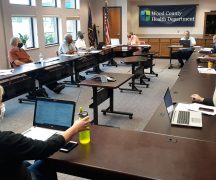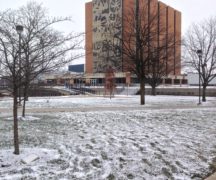By JAN LARSON McLAUGHLIN
BG Independent News
BGSU is turning to remote learning, trying to thin out residency on campus and setting aside one apartment building for isolation of students with COVID. Gov. Mike DeWine has ordered bars to pour their last drinks at 10 p.m., then close at 11 p.m.
University, city and public health officials are working to make sure some of those actions don’t result in just shifting the risk elsewhere when students return to classes on Aug. 26.
(Editor’s note: The above photo is from the opening of fall classes in 2017 – when times were very different.)
Local leaders want to ensure students giving up their campus housing in exchange for $1,500 don’t instead overcrowd apartments and houses off campus. And they want to prevent drinking in bars from spilling over into large drinking parties at off-campus housing after the early closing time.
The Wood County Board of Health had several questions Thursday evening about how Bowling Green would avoid large risks of growing coronavirus cases as students return.
At the same time, the board had questions about how BGSU students would undergo testing, contact tracing and quarantining.
Wood County is currently seeing between 15 and 18 new COVID cases a day, according to Acting Health Commissioner Amy Jones. Many of the new cases are clusters in families with members contracting the virus as private gatherings.
“It’s going to get worse as we go into the fall,” Jones said.
BGSU Chief Health Officer Ben Batey, who previously served as Wood County health commissioner, reported that BGSU would soon be providing contact tracers, in addition to those already in place from University of Toledo and the Ohio Department of Health.
Those contact tracers will also be working with local K-12 school districts on tracking COVID among students and staff.
So far, the students on campus have been cooperative about testing, contact tracing and quarantining, Batey said.
Falcon Landing Apartments, with 110 beds, will be dedicated to isolation housing for students needing to quarantine.
The effort to “de-densify” campus housing to one student per room is going well, with more than 1,000 students giving up their campus residency in exchange for $1,500.
“We’re getting closer to accomplishing the goal,” of getting 2,000 to find other housing, Batey said.
However, that raises concerns about students overcrowding off-campus rental housing. Batey said the university is working with local landlords to monitor the off-campus housing situation.
Also concerning is the governor’s order that bars set 10 p.m. for last call on drinks, and 11 p.m. for closing time – three hours earlier than customary. The worry is that large intoxicated groups of students won’t disband, but just move elsewhere.
“We don’t want any gatherings at off-campus residences of more than 10 people,” Batey said, citing the governor’s order on the number of people allowed to gather.
If the police have to intervene at large parties, the students on the lease will be reported to BGSU Student Affairs, with possible penalties for violating the university code of conduct, Batey said.
“The majority of students are outside the campus, in the community,” he said.
Bowling Green Police Lt. Dan Mancuso said Friday morning that officers will respond to complaints about large or loud parties. In most cases, officers will focus on educating those present about the risk of large gatherings.
The issuing of citations will depend on how serious the violation, and the history of other complaints at the same address, Mancuso said.
Bowling Green city and university officials have been working on other plans to limit the spread of COVID-19 when students return. Those plans will be announced next week.




